Stomach Acid-Fueled Micromotors Show Promise For Diagnostics, Drug Delivery

Scientists from the University of California San Diego (UCSD) have set stomach acid-fueled micromotors loose inside the stomach of a mouse. Researchers claim the technology may someday be useful as a novel drug delivery system and diagnostic tool.
The motors measure one fifth the size of a human hair and are fitted with a zinc body that reacts to stomach acid. This reaction releases a stream of hydrogen bubbles that propels the motors around the stomach. After approximately ten minutes, the motors dissolve within the stomach lining, leaving no toxic traces behind, according to a press release from UCSD.
The UCSD research team was led by Joseph Wang and Liangfang Zhang, both of whom are professors in the nanoengineering department of UCSD Jacobs School of Engineering. This project is the latest of many designs developed by their team, which is working to develop motors that can travel autonomously within the body.
These latest results are based on initial findings published in the Journal of American Chemistry Society in 2012, a study that tested the same micromotors in acidic environments. The latest study was the first to test the technology in a living organism.
“This is the first example of loading and releasing cargo in vivo,” Wang said in the press release. “We thought it was the logical extension of the work we have done, to see if these motors might be able to swim in stomach acid.”
Zhang added: “This initial work verifies that this motor can function in a real animal and is safe to use.”
The researchers loaded the motors with nanoparticles of gold and found that three times as many particles reached the stomach lining with the motors (168 nanograms) than when the particles were simply swallowed (53.6 nanograms). Additionally, the team tested the zinc motors against platinum motors and found that four times as many reached the stomach lining.
Because the zinc motors are cone-shaped and can reach speeds of 60 micrometers per second, they are especially effective in sticking in the stomach wall.
Zhang explained in the press release: “It’s the motor that can punch into this viscous layer and stay there, which is an advantage over more passive delivery systems.”
Wang, Zhang, and their team published their study in ACS Nano, and discussed the technology’s enormous potential.
“Artificial micromotors, operating on locally supplied fuels and performing complex tasks, offer great potential for diverse biomedical applications, including autonomous delivery and release of therapeutic payloads and cell manipulation,” the research team wrote in the article.
The UCSD team hopes that further research and development will refine the capabilities of their motors by adding navigational systems that can be directed towards a specific target.
Image Credit: Jacobs School of Engineering/UC San Diego
